Milton Avery’s star has been on a slow yet steady ascendance. Yesterday, a fresh and austerely handsome retrospective on Avery, comprising nearly 70 paintings, opened at London’s Royal Academy of Arts after well-received presentations this past year at Fort Worth’s Modern Art Museum and Hartford’s Wadsworth Atheneum. The London showing is the first comprehensive museum exhibition of Avery ever to take place in Europe.

Throughout his long life, Avery continually seemed to be working in the wrong style at the wrong time. It didn’t help matters that it was a long slog for him to even become an artist, despite his admirable dedication. Born in 1885 in Altmar, New York, and raised in Connecticut, Avery spent his teen and early adult years toiling away at menial factory and clerical jobs in and around Hartford; he took art classes during his off-hours.
At 30, finally getting local recognition for his sensitive American Impressionist impasto landscapes of New England, he was eclipsed by the competing trends of European modernism and American social realism. Avery moved to New York in 1925 and the following year married the artist Sally Michel (who worked as an illustrator to support him).
Finally, in the 1940s, he hit his stride with increasingly reductive, colorful, and quietly tonal paintings—the poetic landscapes, portraits, and still lifes for which he is still best known.
After World War II, Avery was taken on by some of New York’s most prominent art dealers, including Valentine Dudensing, Pierre Rosenberg, and, later, Grace Borgenicht. But he suffered a serious and debilitating heart attack in 1949, just as the Abstract Expressionist movement began to dominate critical art circles, which were succumbing to the dictates of finicky taste-makers such as Clement Greenberg.
Avery “arrived” in 1960 when he was the subject of a major retrospective organized by the Whitney Museum, in New York. Alas, by the time he died, in 1965, the “youthquake” and Pop-art culture had cast yet another critical shadow over his work.

The Royal Academy exhibition offers a fresh interpretation of Avery’s artistic influence on the Abstract Expressionist and color-field movements, and convincingly gives him his rightful place in art history. While this notoriously reticent man offered up little concerning his artistic motivations, he enjoyed very close friendships with the New York School artists Mark Rothko, Adolph Gottlieb, and John Graham. Many saw him as an older mentor.
Particularly admired were his thin washes and the soft-edged contours that produced works of joyful luminosity, techniques that others borrowed for their own abstract canvases. Avery’s late Provincetown paintings, which verge toward but never are complete abstractions, conclude the show, and assure us that there was always only one Milton Avery. We simply needed to know him better. And now we do. —Charlie Scheips
“Milton Avery: American Colourist” is on view at London’s Royal Academy of Arts through October 16
Charlie Scheips is a painter, writer, and curator living in New York City


 Discover
Discover